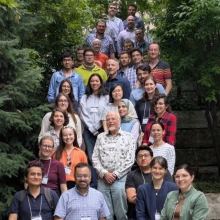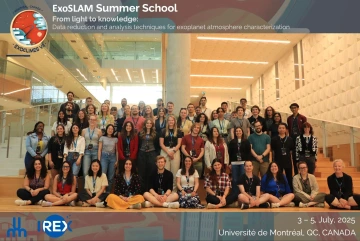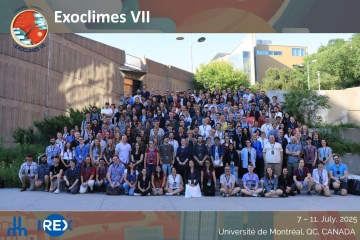The Shirley D. Curson Education Plus Fund in Planetary Sciences and LPL (formerly the Shandel Education Plus Fund) was established by Shirley Curson, a generous donor and friend of LPL, for the purpose of supporting travel expenses outside the state of Arizona during summer break. The award is open to students in the Department of Planetary Sciences and Lunar and Planetary Laboratory who propose to fund study, museum visits, special exhibits, seminars, instruction, competitions, research and other endeavors that are beyond those provided by the normal campus environment and are not part of the student’s regular curriculum during the recipient’s school year.
2025 Recipients: Naman Bajaj, Maizey Benner, Lori Huseby
Naman Bajaj

Thanks to the Curson Travel Award, I had the opportunity to attend the RAVEYSO (The role of accretion and ejection variability in the evolution of young stars and their disks) workshop at the European Southern Observatory (ESO) in Garching, Germany. The conference was directly aligned with my research interest in understanding the various processes involved in planet formation. This was my first time visiting ESO, and being in that environment, surrounded by people who think deeply about young stellar accretion, jets, and winds, was both energizing and grounding. The meeting struck a great balance between formal talks and informal conversations, which made it easy to connect with others whose work intersects with mine.

I presented a talk titled “The Wind-Jet-Accretion Connection: Insights from Spatially Resolved Jets and Winds with JWST,” and shared recent results from our collaboration that I’m excited about. The feedback was thoughtful, and several conversations sparked ideas that will directly inform the next stage of my research, especially as I begin work on my NASA FINESST project. One particularly fruitful exchange has already led to a new observational proposal, using the Very Large Telescope (VLT) in Chile, that I’m now leading, something that wouldn’t have happened without this trip. It was also really rewarding to see my earlier work resonate with others in the field.
Beyond the science, this conference gave me a deeper sense of connection to the community and where my research fits in. I left with new collaborators, fresh momentum, and a clearer sense of direction for upcoming projects. I'm very grateful to the Curson Travel Award for making this possible. It was a meaningful experience, both professionally and personally.
Maizey Benner

The Curson Travel Award supported my participation in the Canadian Center for Electron Microscopy (CCEM) Summer School at McMaster University in Hamilton, Ontario. This workshop was extremely impactful in expanding my knowledge and skills in electron microscopy.
I participated in theoretical lectures and hands-on demonstrations that allowed me to understand the cutting-edge of electron microscopy research. The lectures were useful in both refreshing and expanding my knowledge in different spectroscopic techniques and allowed me to learn from the field’s foremost experts. One highlight was seeing both a lecture and demonstration on 4-dimensional scanning transmission electron microscopy (4DSTEM) by Dr. Colin Ophus, one of the leading developers of open-source software tools and nanoscale 4DSTEM research. I also learned the details of performing tomographic experiments on the ThermoFisher Talos, and milli-electron volt resolution electron energy loss spectroscopy experiments on the Nion ULTRASTEM. These are some of the most powerful transmission electron microscopes available.

This experience expanded my knowledge, awareness, and passion in transmission electron microscopy. It was an incredible privilege to learn from the top researchers in the field and gain experience using different types of transmission electron microscopes. Most importantly, I was able to take away new knowledge and skills to use in my own research. My graduate research at LPL focuses on the origins and evolution of moderately volatile elements in primitive meteorites and returned samples. Currently, I am conducting a coordinated analytical study on sulfide minerals in Bennu and Ryugu, with a focus on transmission electron microscopy techniques. This workshop gave me new techniques to expand my research and gain further insights into the origins of sulfide minerals on Bennu.
Lori Huseby
The Curson Travel Award allowed me to travel to Montréal, Quebec, Canada to attend the ExoSLAM Summer School and the subsequent Exoclimes VII conference which took place at the Université de Montréal from July 3 - 11, 2025. This conference and summer school was centered on a small community of early career through specialists in the field who come together to talk about exoplanet climates, which included atmospheric dynamics, chemistry, clouds and aerosols, surface-atmosphere interactions, and atmospheric escape. My work involves both laboratory and modeling work, so this conference was perfect to showcase my experiments and the importance of laboratory work in future modeling efforts of exoplanet atmospheres.
The ExoSLAM Summer School was a 2.5 day workshop including ~50 early career researchers in the field of exoplanet climates, which provided an exceptional networking opportunity and I was able to gain the skills necessary to continue to progress in the field. The lectures included introductions to spectroscopic methods, atmospheric retrievals of data from the James Webb Space Telescope (JWST), and high-resolution atmospheric interpretations using the next generation of large ground-based telescopes. We then had hands-on sessions on JWST instrument selection for future proposals, machine learning and how it can be applied to our work, and how to use pipelines to interpret our observations. We finished with a panel on early career questions and how best we can progress through our work and next steps after graduate school.
After a brief break to explore the city, the Exoclimes VII conference began involving ~200 specialists in the field. This made it much easier to network and have conversations with experts in the field and for them to see your work in a less stimulating environment. I had the opportunity to present a poster titled “Optical Properties and Spectral Features of Sub-Neptune Water-World Hazes After UV-Irradiation Through Laboratory Experiments.” This poster allowed me to speak to many modelers and observers alike to describe and demonstrate the need for more optical properties of exoplanet hazes in the field and advocate for exoplanet lab work in general. I also saw many interesting talks on new observational research and it helped me shape what I want to pursue for the rest of my graduate career. In addition, there were panels on science communication, which included breakout sessions conversing with others of different backgrounds, and going beyond academia into other future opportunities in the conference. There was a field trip aspect as well where we were able to visit a cider house for a tasting and more informal science conversations with other participants. I am very grateful to the Curson Travel Award for allowing me to present my work and forge potential future collaborations in the field of exoplanet climates.
Image

| Image

| Image

|

